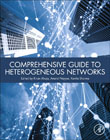
Comprehensive Guide to Heterogeneous Networks
Sharma, Kavita
Nayyar, Anand
Ahuja, Kiran
Comprehensive Guide to Heterogeneous Networks discusses the fundamental motivations behind this cutting-edge development, followed by a brief discussion about the diverse definitions of HNs. The future of the heterogeneous wireless networks (HWNs) is covered which includes test cases, cost configuration, economic benefits and basic challenges. In the second section, an exploitation and topology management method are presented in context of heterogeneous sensor nodes with diverse communication and sensing range. Heterogeneous wireless sensor network (HWSN) consists of sensor nodes with different capabilities viz. dissimilar computing power and sensing range. As compared to homogeneous WSN, deployment and topology management are more complicated in HWSN. An outline of the pros and cons of the clustering criteria in HWSNs and taxonomy are summarized and conclude the section with some futuristic research directions. The final section discusses the future evolution of HNs along with their implementations in diverse applications in current era. Evolving 5G and beyond communication networks are envisioned as an application of HNs. It facilities real-time networks with substantial connectivity, excessive high data rate, ultralow latency, improvised security, very low energy consumption, and exceptional quality of experience (QoE). In order to attain full convergence of the HNs, many technical issues need to be resolved, which are deeply considered in this section. This is an essential reference book for advanced students on courses in wireless communications, clinical engineering and networking. It will also be of interest to researchers, network planners, technical mangers and other professionals in these fields. Discusses the most important problems, challenges and issues which arise when designing real-time heterogeneous networks for diverse scenarios Represents the unique features of heterogeneous sensor networks which gives the end user a better understanding of the environment Provides an overview of real-time performance issues in heterogeneous networks, specifically about multi-tasking, multi-level scheduling, localization and security issues Includes applications of heterogeneous networks in diverse fields and also focuses on the convergence of heterogeneous wireless networks for 5G INDICE: SECTION A - INTRODUCTION TO HETEROGENOUS NETWORKS 1. Heterogeneous networks- An overview 2. Challenges in the deployment of heterogeneous wireless networks 3. Load balancing in heterogeneous wireless networks 4. Interface management in heterogeneous wireless networks 5. Network selection and interface management in heterogeneous IoT environment SECTION - B HETEROGENEOUS SENSOR NETWORKS 6. Heterogeneous wireless sensor network structure 7. Routing protocols and clustering algorithms for HWSNs 8. Energy efficient protocol for heterogeneous wireless sensor networks 9. Management platform for heterogeneous wireless sensor networks 10. Heterogeneous wireless sensor network deployment and topologies SECTION - C REAL-TIME PERFORMANCE ISSUES IN HETERO-GENEOUS NETWORKS 11. Heterogeneous and multi-task wireless sensor networks 12. Multi-level scheduling for heterogeneous wireless sensor networks 13. Localization criteria in heterogeneous wireless sensor networks 14. Security issues in heterogeneous wireless sensor networks SECTION - D APPLICATIONS OF HETEROGENEOUS NETWORKS IN DIVERSE FIELDs 15. Importance of HWSNs in smart cities 16. Implementation of heterogeneous wireless network for industrial applications 17. Mobile healthcare applications over heterogeneous networks 18. Convergence of Heterogeneous Wireless Networks for 5G
- ISBN: 978-0-323-90527-5
- Editorial: Academic Press
- Encuadernacion: Rústica
- Páginas: 350
- Fecha Publicación: 01/09/2022
- Nº Volúmenes: 1
- Idioma: Inglés
